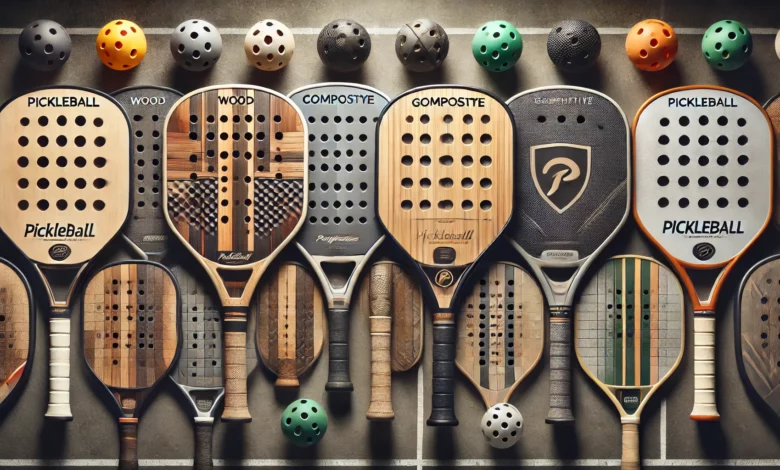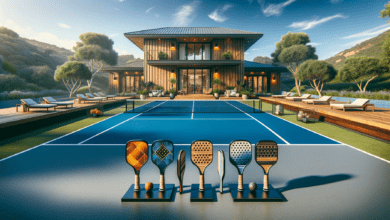Pickleball Paddle Materials: A Comprehensive Guide

Pickleball paddles have undergone significant changes in terms of materials over the years. The choice of material plays a crucial role in paddle performance and can greatly impact gameplay. In this guide, we will explore the different materials used in pickleball paddles and their unique characteristics.
Understanding the different materials used in pickleball paddles is essential for making an informed choice that aligns with your playing style and preferences. Stay tuned as we delve deeper into the impact of pickleball paddle surface materials and core materials in our upcoming sections.
Also read: Top 10 Best Pickleball Rackets – The Best Paddles
Also read: Top 10 Best Budget Pickleball Rackets – Cheap Pickleball Paddles
Also read: Pickleball Paddle Materials: A Comprehensive Guide
Key Takeaways:
- Graphite paddles offer lightweight and rigid construction for consistent strikes and greater energy transfer.
- Carbon fiber paddles provide refined play with even energy distribution, resulting in control and spin.
- Fiberglass paddles are known for their durability and power, but have a smaller sweet spot.
- Hybrid paddles combine different materials to achieve a balance between power and touch.
- Wooden paddles, although less popular in modern play, offer power but lack control.
The Impact of Pickleball Paddle Surface Materials on Gameplay
When it comes to pickleball paddle materials, the surface or face material is a crucial factor that can greatly influence gameplay. Different surface materials offer unique characteristics that can affect a player’s ability to generate power, control the ball, and achieve spin.
Graphite paddles are known for their thin and light construction, which allows for a consistent strike and efficient energy transfer. These paddles are best suited for players who rely on touch and finesse to outmaneuver their opponents on the court.
Carbon fiber paddles, on the other hand, are made of interlinked carbon fibers that provide a refined feel and excellent energy absorption. These paddles offer a balance between power and control, making them suitable for players seeking precision in their shots.
“The choice of surface material impacts the player’s ability to generate power, control the ball, and achieve spin.”
Fiberglass paddles are power-driven and have a smaller sweet spot compared to other materials. Made by compressing fibers and resin, these paddles are durable but require more precision in shot placement to achieve the desired outcome.
By understanding the impact of different surface materials on gameplay, players can make an informed choice when selecting their pickleball paddle. It’s important to consider personal playing style and preferences to find a paddle that enhances performance and maximizes enjoyment on the court.
| Surface Material | Characteristics |
|---|---|
| Graphite | Thin, light, consistent strike, efficient energy transfer |
| Carbon Fiber | Refined feel, excellent energy absorption, balance of power and control |
| Fiberglass | Power-driven, smaller sweet spot, durable |
The impact of surface materials on gameplay
- Graphite paddles offer consistent strikes and efficient energy transfer, suitable for players who rely on touch and finesse.
- Carbon fiber paddles provide a refined feel, excellent energy absorption, and a balance between power and control.
- Fiberglass paddles are power-driven, but they have a smaller sweet spot and require more precision in shot placement.
Choosing the right surface material for a pickleball paddle is a personal decision that should be based on individual playing style and preferences. Whether you prioritize power, control, or a combination of both, understanding the impact of different surface materials can help you make an informed choice and elevate your gameplay to new heights.
Pickleball Paddle Core Materials: The Key to Performance

When selecting a pickleball paddle, it is crucial to consider the core material, even though it may not be visible at first glance. The core material plays a fundamental role in determining the paddle’s performance and characteristics. There are three main core materials used in pickleball paddles: polymer, aluminum, and Nomex.
Polymer cores, made from polypropylene, are lightweight and offer a balanced combination of touch and power. They provide players with excellent control while still delivering enough power for effective shots. Additionally, polymer cores are highly durable, ensuring that the paddle can withstand long hours of play.
On the other hand, aluminum cores offer strength and consistency. These cores provide increased power upon striking the ball, making them ideal for players who prefer a more powerful playing style. Although aluminum cores may be slightly heavier, they offer stability and enhanced performance that can benefit experienced players.
Lastly, Nomex cores are known for their high-impact resistance and noise absorption properties. These cores are exceptionally durable and offer excellent control. However, Nomex cores tend to be heavier, which may affect maneuverability for some players.
Key Points:
- Polymer cores provide a balance between touch and power, making them ideal for players seeking control and durability.
- Aluminum cores offer strength and consistency, delivering increased power on strikes for players who prefer a more powerful playing style.
- Nomex cores are highly durable with excellent control, but their weight may impact maneuverability.
By understanding the importance of core materials, players can make an informed decision based on their playing style, preferences, and desired performance. The table below summarizes the key characteristics of pickleball paddle core materials.
| Paddle Core Material | Characteristics |
|---|---|
| Polymer | Balance between touch and power Durable Lightweight |
| Aluminum | Strength and consistency Increased power on strikes |
| Nomex | High-impact resistance and noise absorption Excellent control |
Factors to Consider When Choosing a Pickleball Paddle
When selecting a pickleball paddle, several factors should be taken into account to ensure the right fit for your playing style and preferences. These factors can greatly impact your performance on the court. Here are some key considerations:
- Skill Level: Your skill level as a player is an important factor in determining the type of paddle that suits you best. Beginners may benefit from paddles with a classic shape and size, which offer a good balance of power and control. More experienced players may opt for specialized paddles that cater to their specific style of play.
- Grip Size and Handle Length: The grip size and length of the handle are crucial for optimal comfort and control. It’s important to choose a paddle with a grip size that feels comfortable in your hand, allowing for a secure hold and ease of maneuverability. Likewise, the length of the handle should be suitable for your hand size and playing style.
- Paddle Weight: The weight of the paddle can significantly impact your game. Heavier paddles offer more power behind your shots but can be less maneuverable. Lighter paddles, on the other hand, provide increased maneuverability but may sacrifice some power. Consider your strength and playing style when choosing the weight of your paddle.
In addition to these factors, the choice of paddle material, surface material, and core material should align with your desired level of power, control, and spin. It’s important to experiment with different paddles to find the one that feels comfortable and suits your playing style the best. Keep in mind that selecting the right paddle can enhance your overall pickleball experience and contribute to improved performance on the court.
Expert Tip:
“When choosing a pickleball paddle, it’s always a good idea to try out different options before making a decision. Take advantage of demo programs offered by local sports stores or ask fellow players to borrow their paddles for a game. This way, you can get a feel for different paddle characteristics and make an informed choice.”
Comparative Table: Paddle Features
| Paddle Feature | Graphite | Carbon Fiber | Fiberglass | Wood | Hybrid |
|---|---|---|---|---|---|
| Weight | Lightweight | Lightweight | Moderate | Heavy | Varies |
| Power | Good | Balanced | High | High | Varies |
| Control | Good | Good | Moderate | Moderate | Varies |
| Spin | Good | Good | Moderate | Low | Varies |
| Durability | Good | Good | Moderate | High | Varies |
Conclusion
In conclusion, the choice of pickleball paddle materials is a crucial consideration for players looking to enhance their gameplay. Graphite, carbon fiber, fiberglass, wood, and hybrid options each offer unique characteristics that cater to different playing styles and preferences. Whether you prioritize lightweight and rigid strikes, refined play and control, durability and power, or a balance between power and touch, there is a paddle material that suits your needs.
Furthermore, the surface material of the paddle also significantly impacts gameplay. From consistent strikes and energy transfer provided by graphite paddles to the refined feel and excellent energy absorption of carbon fiber paddles, each surface material has its own advantages. The choice of surface material affects your ability to generate power, control the ball, and achieve spin on the court.
Additionally, don’t overlook the importance of the core material when selecting a pickleball paddle. Whether it’s the balance between touch and power offered by polymer cores, the strength and consistency of aluminum cores, or the high-impact resistance and noise absorption of Nomex cores, the core material plays a vital role in the paddle’s performance.
By considering your skill level, playing style, personal preferences, grip size, handle length, and weight, you can make an informed decision and choose a pickleball paddle that aligns with your desired level of power, control, and spin. So, take your time, explore the options, and select the perfect combination of pickleball paddle materials that will elevate your game to new heights.
Also read: Top 10 Best Pickleball Sets with Rackets and Balls
Also read: Top 10 Best Pickleball Sets with Net


